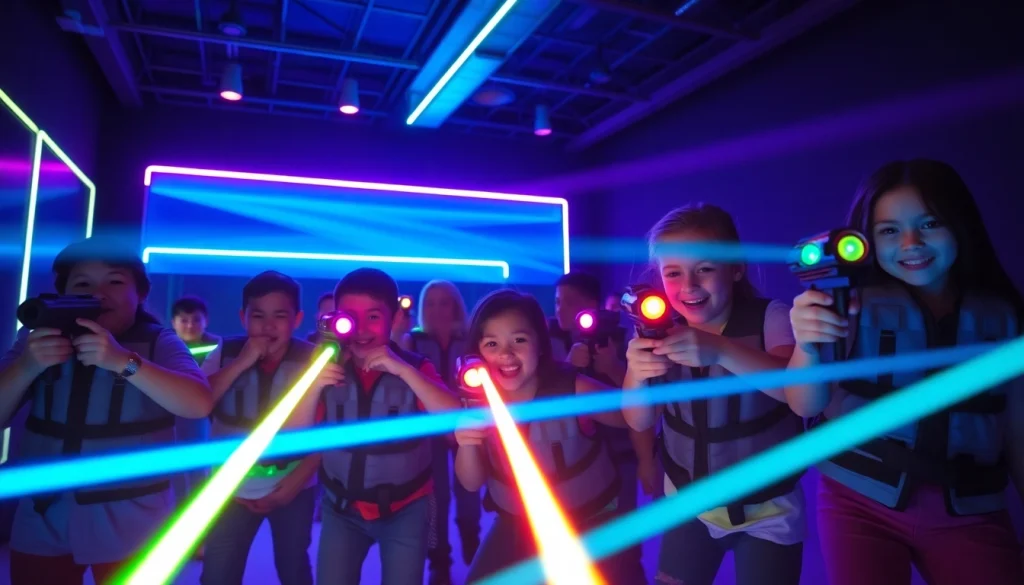Understanding Laser Tag: Basics and Beyond
What is Laser Tag?
Laser tag is an exhilarating recreational shooting sport where players utilize infrared-emitting light guns to “tag” opponents or designated targets in a structured arena. Often disguised as a thrilling game of stealth and strategy, laser tag requires teamwork, quick thinking, and effective communication among players. This engaging activity has gained immense popularity in family entertainment centers, sports arenas, and competitive leagues across the globe. As you prepare for some action-packed fun, you might want to check out local options for laser tag.
History and Evolution of the Game
The roots of laser tag can be traced back to the late 1970s when the concept emerged from military training exercises that used infrared technology to simulate combat scenarios. The first commercial iteration was developed by George Carter III, who introduced the game as “Laser Tag” in 1984, transforming it into an indoor and outdoor experience suitable for all ages. Since then, laser tag has diversified, adopting various technological advancements, game formats, and immersive themes to enhance player experiences.
Key Rules and Gameplay Mechanics
The fundamental premise of laser tag is simple. Players are equipped with a laser tagger and a vest or sensors that track hits and scores throughout the game. Each player receives a certain number of lives or “hit points,” and the objective is to score points by tagging opponents while avoiding being tagged yourself. Initially, a game briefing outlines basic rules regarding player conduct, objectives, and safety protocols. Players must remain alert and strategically navigate the arena while collaborating with their teammates to dominate the game. Gameplay often includes power-ups and special abilities depending on the arena’s design and the technology used.
Types of Laser Tag Experiences
Indoor vs. Outdoor Laser Tag
Laser tag can be played in both indoor and outdoor settings. Indoor laser tag typically features controlled environments with obstacles, themed arenas, and strategic gameplay designs. The advantage of indoor arenas lies in consistent weather conditions, ideal for year-round play. In contrast, outdoor laser tag presents players with vast fields or parks, often integrating natural terrains into gameplay. Players might encounter different challenges outdoors, including varied weather conditions that can add excitement to their experience. Each format has its unique set of strategies and advantages, making player preferences diverse.
Laser Tag Arenas and Equipment
Modern laser tag experiences are enhanced by state-of-the-art equipment and immersive arenas. Most arenas are designed with obstacles, barriers, and strategic hiding spots to replicate battlefield conditions. Equipment typically includes lightweight, ergonomic laser guns equipped with features such as adjustable settings for firing rates, different attack modes, and tactical scopes for improved accuracy. The vests or sensors worn by players not only detect hits but may also offer feedback through lights and sound effects, enhancing the overall immersion of the gameplay.
Different Game Formats and Themes
Various game formats cater to diverse player demographics and preferences. Standard formats might include team deathmatches, capture the flag, or free-for-all battles. Additionally, venues often introduce creative themes that align with popular culture, such as sci-fi or horror, giving players unique experiences beyond typical gameplay. Special events, like neon glow or black-light laser tag, further enhance these themed experiences by utilizing vibrant visual effects and immersive soundtracks.
Health and Social Benefits of Playing Laser Tag
Physical Activity and Fitness
Laser tag promotes physical fitness as it involves running, dodging, and strategizing, which contribute to cardiovascular fitness and muscle endurance. The game encourages players to be active, improving agility, coordination, and overall physical health. A typical session can provide a form of aerobic exercise sufficient to burn calories, making it an excellent alternative to sedentary video gaming or indoor activities.
Teamwork and Communication Skills
One of the most significant social benefits of laser tag is the enhancement of teamwork and communication skills among participants. Players must collaborate to devise strategies, execute tactics, and share responsibilities to win the game effectively. These experiences translate to valuable life skills, such as conflict resolution and effective communication, which are essential in everyday situations and various settings.
Stress Relief and Fun for All Ages
Engaging in laser tag not only serves as a thrilling interruption from daily routines, but it also acts as a form of stress relief. The competitive yet friendly atmosphere encourages laughter, camaraderie, and enjoyment, making it accessible for people of all ages. Families, friends, and coworkers benefit from participating in laser tag as a shared activity that fosters relationships, fun, and a sense of community.
Planning Your Next Laser Tag Event
Choosing the Right Location
When organizing a laser tag event, selecting the right venue is crucial. Consider factors like the size of the arena, availability, logistics, and the type of laser tag experience offered. Many facilities provide organized events for birthdays, team-building exercises, and group outings, often equipped with packages that include food, beverages, and personalized services. Check online reviews and ratings to ensure a memorable experience for your group.
Tips for Organizing a Laser Tag Party
Planning a laser tag party involves consideration of various elements. Start by forming a guest list and coordinating with the venue for an available date and time. Testimonials from previous players can provide insight into the venue’s reputation. It’s essential to discuss any special requests, such as custom themes or specific game formats, to create an unforgettable experience. Lastly, providing simple snacks and refreshments can enhance the overall enjoyment of the event.
What to Expect: A Typical Adventure
A typical laser tag adventure begins with a game briefing where an instructor outlines the rules and safety protocols. Players are then equipped with their lasers and vests, given a chance to familiarize themselves with the equipment. The arena experience itself is an intense mix of strategy and adrenaline, as players navigate through obstacles, engage in tactics, and score points. At the end of the session, scores are calculated, often adding an element of friendly competition as players celebrate victories and learn from losses.
The Future of Laser Tag: Innovations and Trends
Technology Advancements in Laser Tag Equipment
The future of laser tag is bright as technology continues to evolve, significantly enhancing gameplay. Innovations include augmented reality experiences, advanced tracking systems, and interactive gaming elements that can change dynamics during the game. Some facilities are integrating mobile app technology that allows players to track their performance, access game statistics, and even engage in virtual challenges outside of physical gaming arenas. These advancements promise to keep laser tag relevant and exciting for newer generations.
Popular Destinations for Laser Tag
With the growth of laser tag, several destinations have emerged as hotspots for enthusiasts. Major cities and entertainment hubs often feature dedicated laser tag arenas packed with thematic elements and multiple gaming options. Urban Air, Main Event, and Xtreme Warrior Tag are examples of venues that offer comprehensive laser tag experiences, combining various activities with dining and arcade options for an all-inclusive day of entertainment.
Community and Competitive Events
As interest in laser tag continues to expand, so do opportunities for community involvement and competitive events. Local and regional tournaments provide players with a chance to hone their skills, compete for prizes, and form lasting friendships within the community. Special events, such as night tournaments or charity fundraisers, also create an opportunity for participants to engage in the excitement of laser tag while giving back to their communities.





